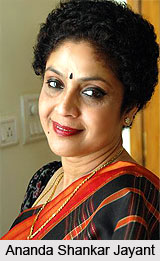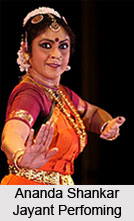 " Dance to me has always been the manifest expression of the unmanifest impression. Yes, dance is not some rarefied, exotic activity, far removed from the perceivable. It is that act, consciously performed, which is a manifestation of the inner self endeavoring to shatter through screens of illusion to touch `reality`". The illustrious Kuchipudi and Bharatanatyam dancer, Ananda Shankar Jayant have said this. For her dance has always been `just the reason to be; a way to touch eternity`. She has never looked into dance as a hobby or a pastime, or even a career. In the true guru-sishya parampara, she has been trained at the feet of Rukmini Devi Arundale at Kalakshetra. In her six years at Kalakshetra, she mastered in Bharatanatyam, Carnatic music, Veena, Choreography, Nattuvangam, Philosophy. Later on she has also learnt Kuchipudi from Pasumarthy Ramalinga Sastry.
" Dance to me has always been the manifest expression of the unmanifest impression. Yes, dance is not some rarefied, exotic activity, far removed from the perceivable. It is that act, consciously performed, which is a manifestation of the inner self endeavoring to shatter through screens of illusion to touch `reality`". The illustrious Kuchipudi and Bharatanatyam dancer, Ananda Shankar Jayant have said this. For her dance has always been `just the reason to be; a way to touch eternity`. She has never looked into dance as a hobby or a pastime, or even a career. In the true guru-sishya parampara, she has been trained at the feet of Rukmini Devi Arundale at Kalakshetra. In her six years at Kalakshetra, she mastered in Bharatanatyam, Carnatic music, Veena, Choreography, Nattuvangam, Philosophy. Later on she has also learnt Kuchipudi from Pasumarthy Ramalinga Sastry.
Ananda Shankar Jayant is regarded as a `top` grade artiste of Doordarshan. ICCR has empanelled her name in the list of `established` artiste. She has also performed in major festivals in India and abroad. In major festivals, she has been invited to perform Kuchipudi such as Khajuraho, Bhagyachandra Dance Festival, Imphal etc. As a dancer of rare grace and abhinaya, Dr. Ananda is regarded.
 Dr. Ananda is an everlasting artiste coalescing the skills of a performing artiste, teacher, choreographer and researcher, which is a rare combination. This combination has further been conjoined with the administrative skills of a successful bureaucrat.
Dr. Ananda is an everlasting artiste coalescing the skills of a performing artiste, teacher, choreographer and researcher, which is a rare combination. This combination has further been conjoined with the administrative skills of a successful bureaucrat.
Dr. Ananda Shankar Jayant, is a Graduate from Kalakshetra. Dr. Ananda interpenetrates the technique and grammar with a sparkling quality, bristling with life because she dances with joy. She has been heralded as an intelligent and thinking dancer, who has coeval sensibility. In her choreography of solo, group and dance ballets, both traditional and modern, she has adapted the technique to modern themes. Her creations are so vivid in an emotionally charged manner that it strikes down an immediate rapport with the viewer. At the very same time she never turns aside from aesthetic predisposition. The main aim of Ananda Shankar Jayant is to bring the Kalakshetra style of Bharatanatyam as an individual vitality and high-spiritedness. It was marked by `split second tala precision coalescing with the dynamic and the graceful coupled with a commanding and arresting stage presence`.
Ananda is a committed research scholar. She did her M.Phil., in Arts History from Osmania University on the topic `Development of Bharatanatyam - Role of Kalakshetra`, she holds a Ph.D., on the topic `Promotion of Tourism and Culture - Role of Railways` - from Osmania University. Ananda Shankar Jayant has been richly esteemed and widely travelled throughout the world.
 Among the recent awards own by her, "Nritya Choodamani" from Sri Krishna Gana Sabha, Chennai, "Nritya Illavarsi" from Shanmuka Sangeetha Sabha, New Delhi and "Kalaimamani". These are the highest awards given to the performing artists by the Government of Tamil Nadu, Dr Ananda Shankar has won many awards throughout her professional career.
Among the recent awards own by her, "Nritya Choodamani" from Sri Krishna Gana Sabha, Chennai, "Nritya Illavarsi" from Shanmuka Sangeetha Sabha, New Delhi and "Kalaimamani". These are the highest awards given to the performing artists by the Government of Tamil Nadu, Dr Ananda Shankar has won many awards throughout her professional career.
Some critically acclaimed productions created by Ananda include - `Sri Krishnam Vande Jagadgurum`, `Buddham Saranam Gachchami`, `Jonathan Livingston Seagull`, `What About Me?," `Expressions of Truth` on the ideals of the Mahatma, a mixed media work - `An Easel Called Life` with paintings `Navarasa-Expressions of Life`, `Darshanam - An Ode to the Eye` and `Dancing Tales…Panchatantra`.
Today Ananda on a regular basis is invited to speak, and write on art related concerns, by leading art organizations, newspapers and television channels. She is working presently for the concerns that are, `Seeking non-marginalisation of arts in mainstream life.



















